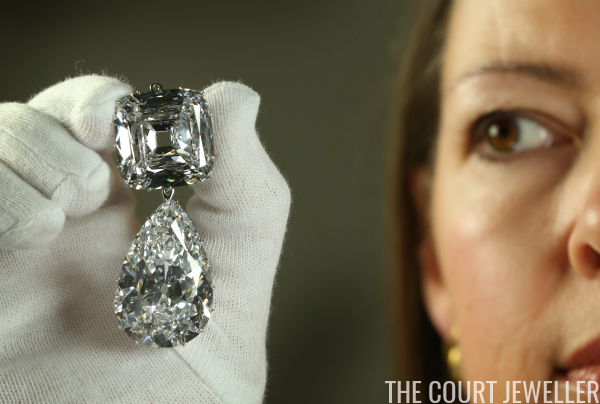 |
| The Cullinan III and IV Brooch displayed during the Queen’s Diamond Jubilee exhibition at Buckingham Palace (Peter Macdiarmid/Getty Images) |
The special correspondent of the London Evening News at Amsterdam sends the first detailed and interesting story of the work of cutting the King’s [1] diamond, which has now been begun in secret in that city. The great work of cutting the Cullinan diamond [2] and preparing it for its place among the crown jewels of England was begun (says our special correspondent) on Saturday.
All the members of the firm entrusted with the work — Messrs. I.J. Asscher [3], who have a gigantic “fabriek” in the Tolstraat, not far from the center of town — are now in Amsterdam. The actual splitting operation is to take place this week in the presence of several experts and a small number of privileged persons in the trade, who have obtained special permission from the authorities in London. Naturally, in such a case the greatest secrecy is observed, but I have been fortunate enough to ascertain many interesting facts in connection with the remarkable work that is being carried out.
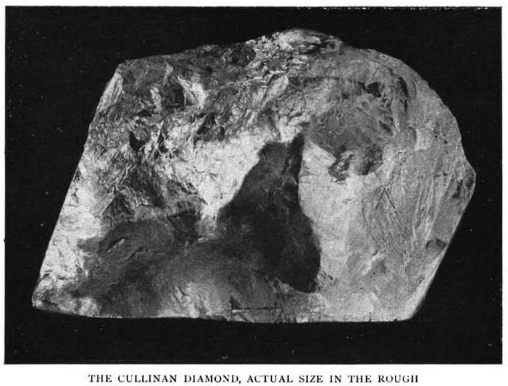 |
| (The Century Illustrated Monthly Magazine, 1909) |
It is some time now since the firm received the great diamond, but the intervening weeks have been spent in hard thinking and studying as to the best methods of cutting it. The first problem that Mr. Joseph Asscher [4], the head of the firm, had to solve was how to cut the diamond so as to eliminate some very bad spots existing in it. For this purpose, a special model of the diamond in clay was made. On this model has been concentrated the attention of the firm. It was cut into pieces to give an idea of what would happen if the genuine stone were treated in the same way.
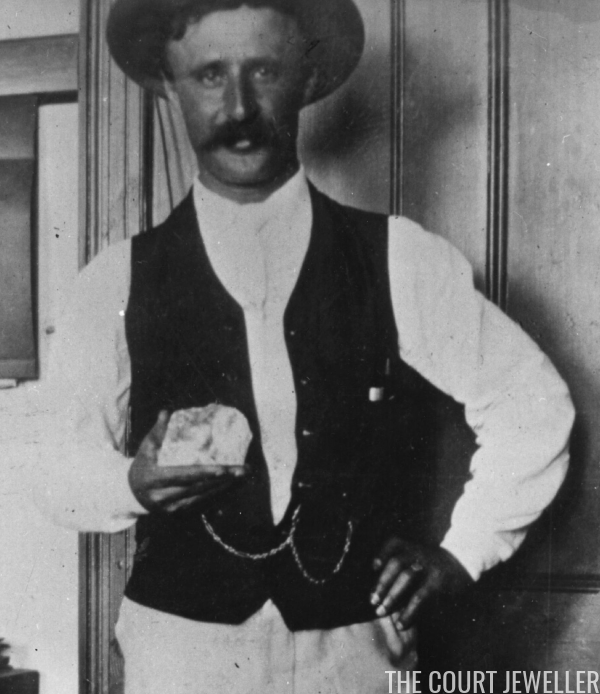 |
| Frederick Wells, surface manager of the mine where the Cullinan was found, holds the rough diamond, 1905 (Fox Photos/Getty Images) |
A special table, not fixed to the floor, has been manufactured for the cleaving operation, as has also a special “bak” or box. When a stone has to be split, diamond cutters use a small box with broad projecting nails on each side on which to steady both arms and hands, while the incision which precedes the splitting is being made. In this case, however, a special box, four times the ordinary size, with sliding sides, has been erected. Special wooden sticks have also been manufactured for the cutting process.
The diamond is to be embedded in cement, placed on the top of a stick, not unlike the stick of a big drum. Then it will be held firmly in the left hand over the box against the projecting nail while the right hand will hold a thin wooden stick, also with cement on top, on which is embedded a sharp cutting diamond, edge upward. The sharpest diamonds obtainable have been bought for this purpose.
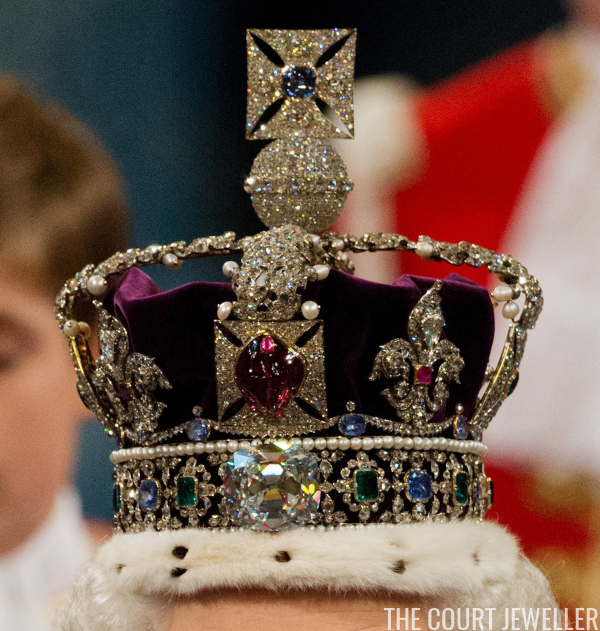 |
| The Cullinan II set at the base of the Imperial State Crown; the cushion-cut diamond weighs 317.4 carats (Suzanne Plunkett – WPA Pool/Getty Images) |
The process of cutting into the diamond is necessarily a very slow one, as it is not an ordinary stone, and the greatest care is being observed. The incision is to be a certain depth — probably from one-half to three-quarters of an inch — and it will be some two or three days before the desired depth has been reached. It is interesting to note that a diamond, like wood, has its grains, and each stone has only four grains by which it can be cloven.
In cases of small diamonds, when the imperfections cannot be erased by cutting through the grain at any point, the saw is brought into use to make the division. The saw had been thought of in this case, but this idea was abandoned owing to the length of time such a procedure would occupy, and, above all, because of the danger there would be of the saw going in the wrong direction after having reached a certain point.
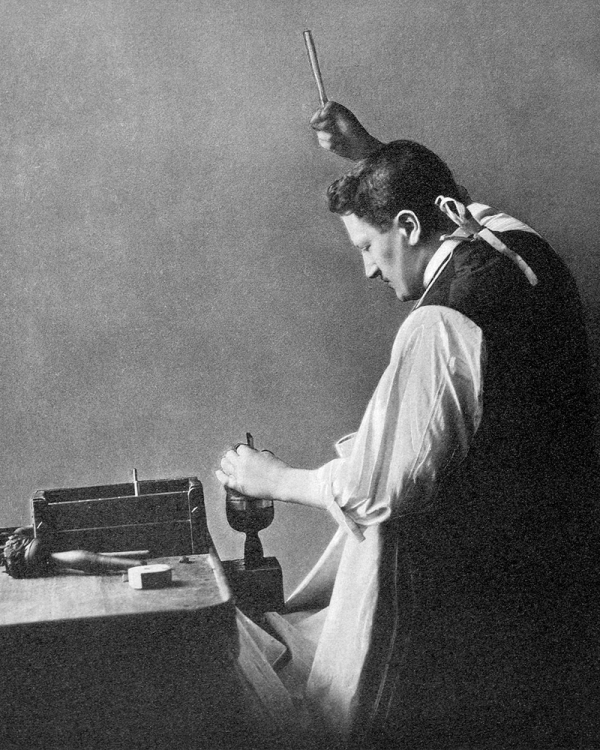 |
| Joseph Asscher cuts the Cullinan Diamond (Wikimedia Commons) |
Once the incision on the King’s diamond is deep enough, this is what will happen. Mr. Joseph Asscher will fix firmly the stick on which it is placed to a thick square piece of lead, insert in the slit a specially-constructed knife blade made of the finest steel, and with a thick steel stick give it a terrific blow. This cuts the stone in twain [5]. The other necessary divisions will be made in a similar manner. In case the diamond should fall, thick carpets have been lain round the table, while the apron which Mr. Asscher wears has its extremities attached to the table as a further precaution.
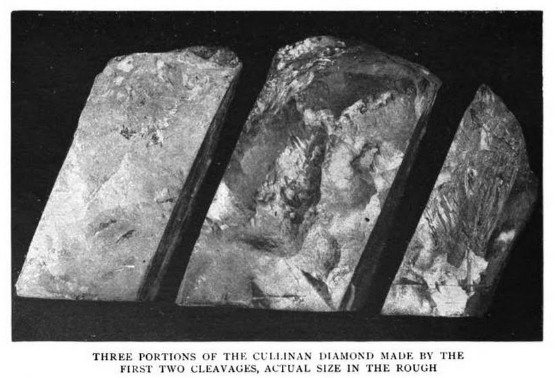 |
| The Cullinan after the initial cleavages (The Century Illustrated Monthly Magazine, 1909) |
Once the above has been achieved, the jewel will be handed over to Herr Henri Koe [6], a strong, keen-looking young man with wrists of iron, who has been in the firm some twenty years. He it was who polished the famous Excelsior diamond [7], weighing 971 carats, on behalf of his firm. He will, while at work, be locked in a specially-built room, together with three assistants and an old member of the firm. For a whole year — the time which it is expected the operation will take — his hours will be from 7 in the morning until 9 o’clock at night. The workmen have 1 1/2 hours for luncheon, but Koe will not leave the room throughout the day. This room is nearly opposite that of the head of the firm, who will retain the key of it, so that he will be able to look in at will and see how the work is going.
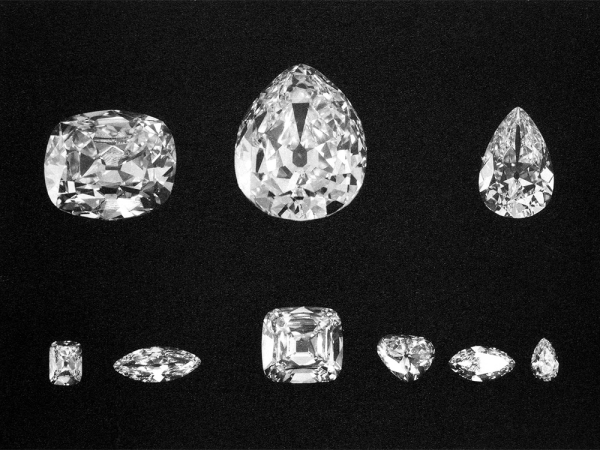 |
| The nine major diamonds that resulted from the cutting of the Cullinan Diamond; the largest two stones, the Cullinan I and Cullinan II, are now set in the Sovereign’s Sceptre with Cross and the Imperial State Crown (Wikimedia Commons) |
The cleaving of a diamond is followed ordinarily by the rubbing of it against a diamond to give it shape, but in the case of the Cullinan this will not be done in case some mishap in the form of a scratch or a splinter in the stone might occur. The polishing of the facets will, therefore, be the next detail. The various instruments required for polishing have been, of course, made much larger in the case of the Cullinan. For instance, a special dop (a sort of big drumstick, with pewter on top, into which, while soft, two-thirds of the diamond will be buried) has been manufactured, weighing about twenty pounds, and measuring 5 1/2 inches across.
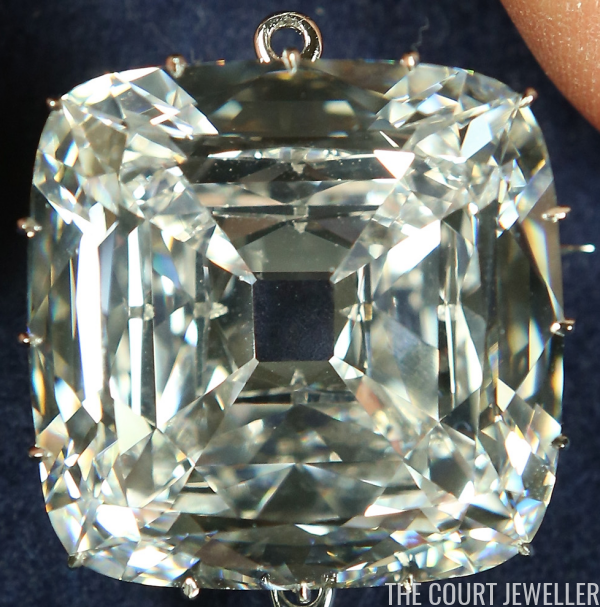 |
| The Cullinan IV, a square-cut diamond weighing 63.6 carats (Peter Macdiarmid/Getty Images) |
The mill, which is made of cast iron and steel, and is 16 1/2 inches straight across (ordinary ones measure about 12 inches, and that used for the Excelsior only 13) makes 2400 revolutions per minute. The diamond has to be applied to the revolving plate gently and carefully, or otherwise there is a good chance of the stone crumbling to pieces. To insure himself against accidents, Herr Koe has had a device specially constructed for himself which will help his wrist. The mill is oiled with a preparation consisting of crushed diamond powder and oil, and a larger quantity than usual of this expensive liquid will be utilized.
There is a strong room on the ground floor of Messrs. Asschers’ premises, which is probably unique. The walls are three-quarters of a yard thick, and made of iron and cement. It would take anybody a fortnight to bore a hole through them. The door can only be opened by a combination of numbers, which is only known to the three heads of the firm. This done, a strong iron-barred door is displayed to view, which has to be unlocked before the strong room can be lit by electric light. The illumination is obtained by joining the electric wire to a switch on the outside of the room, this being done in order to prevent any opening inside.
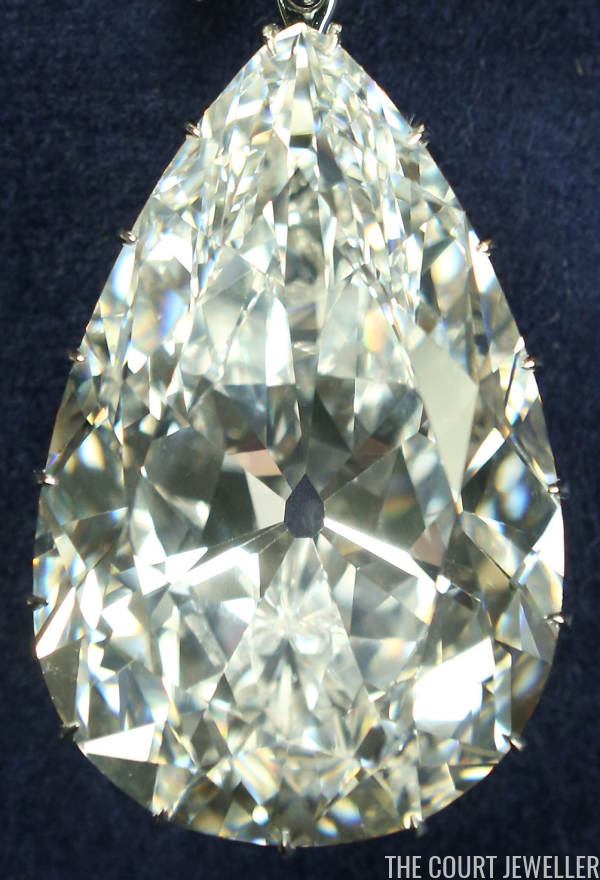 |
| The Cullinan III, a pear-cut diamond that weighs 94.4 carats (Peter Macdiarmid/Getty Images) |
One sees several unpretentious-looking movable desks containing hundreds of thousands of pounds’ worth of diamonds. On the left near the wall there is a mahogany cupboard of ordinary appearance, with two handles, but no locks visible. Locks there are, however — nine in all — behind a sliding panel. The door of the safe for such it is, is of steel, 8 inches thick, and conceals two ingeniously-hidden safes, in one of which the Cullinan diamond reposes at night.
The head of the firm, armed with a revolver, takes the diamond down every evening, accompanied by ten members of his staff, who leave him for a moment while he secretly locks the outer door. They also accompany him in the morning when he takes it out again. There is a small patent recording clock outside the strong room, and it is the duty of the night watchman to make a certain mark on it every half-hour throughout the night. If he is only a second late, he will be called upon to give an explanation. Throughout the night, also, an armed policeman walks up and down the building.
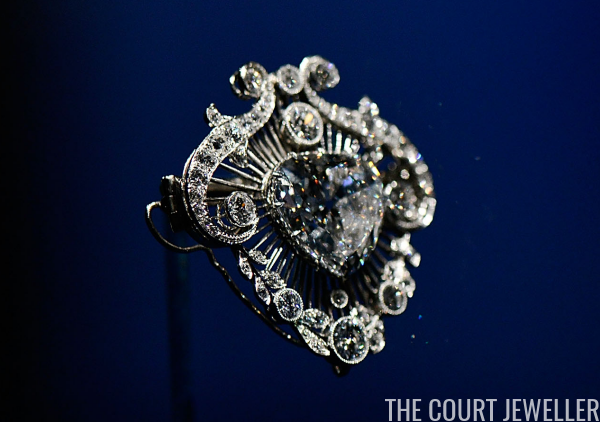 |
| The Cullinan V in the center of its brooch setting; the heart-shaped diamond weighs 18.8-carat (Bethany Clarke/Getty Images) |
The diamond, which now weighs about 1 1/2 pounds will, when complete, weigh about 1 pound. It will have fifty-eight facets, the usual number of every diamond, and will be a beautiful glassy white.
NOTES
1. King Edward VII of the United Kingdom (1841-1910) who was presented with the Cullinan Diamond by the government of the Transvaal Colony on his birthday in 1907.
2. The Cullinan Diamond, the largest gem-quality rough diamond ever discovered, was found in Sir Thomas Cullinan’s Premier No. 2 diamond mine in present-day South Africa in January 1905. The rough stone weighed more than 3100 carats.
The diamond was found by a miner named Thomas Evan Powell. It was subsequently purchased by the government of the then-colony, which eventually convinced King Edward VII to accept it as a gift. (Winston Churchill was a major force in persuading the king.) The diamond made the perilous journey from Africa to England in a plain, unmarked box sent through the post. Once in London, it was accompanied by an agent of the colonial government, Richard Solomon, to the Sandringham estate. Edward VII made Solomon a knight commander of the Royal Victorian Order on the day that the diamond was delivered, which happened to be the king’s 66th birthday.
The diamond was entrusted to the Asscher brothers in January 1908, and the pair took the gem to their workshop in Amsterdam, where the massive stone was cut into nine major diamonds and numerous smaller stones. The largest two are now a part of the British crown jewels, while the seven smaller diamonds are the personal property of Queen Elizabeth II.
3. The Asscher Diamond Company was founded in 1854 as I.J. Asscher by Joseph Asscher. In 1908, the company was owned by two of his grandsons, Joseph and Abraham. The company was seized by the occupying German forces during World War II, and nearly the entire staff, including the Asschers themselves, were interned in concentration camps. Only a handful of the employees survived. Two surviving family members, Joop and Louis Asscher, reestablished the firm in Amsterdam in the late 1940s. The company still exists today, and after being presented with a royal warrant by Queen Juliana in 1980, the firm is now known as the Royal Asscher Diamond Company.
4. Joseph Asscher was one of the two Asscher brothers who owned the eponymous Dutch diamond firm. He was renowned for his invention of the Asscher diamond cut in 1902. When the firm agreed to cut and polish the Cullinan diamond, Joseph was given the responsibility of making the first cut.
5. The article was a bit behind. The first cut was made in February 1908, weeks before the article was published. Even after all of the preparations outlined in this article, the first attempt to cleave the diamond failed when Joseph’s knife broke. A few days later, after altering his strategy and procuring different tools, Joseph cleanly cut the diamond on his first strike. You’ll often hear it said that Joseph fainted after striking the blow, but that appears to be an urban legend. On hearing the story later, Joseph’s nephew, Louis, reportedly scoffed, “No Asscher would ever faint over any operation on any diamond.”
6. Henri Koe (1870-1928), a British-born Dutchman, was the chief cutter at the Asscher firm and had worked for the company for two decades before the Cullinan arrived in their workshop. He was later recognized with the Order of Orange-Nassau.
7. The Excelsior Diamond, which was discovered in 1893 in present-day South Africa, was the largest gem-quality diamond ever found … until the Cullinan was discovered in 1905. Today, it ranks as the third-largest rough diamond of gem quality ever found. In its rough state, it weighed more than 970 carats. Unlike the Cullinan, it was decided to cut the Excelsior into many smaller diamonds. Eleven significant diamonds, the largest weighing about 70 carats, came from the Excelsior. Today, that largest piece, the Excelsior I, is owned by Robert Mouawad.
Leave a Reply